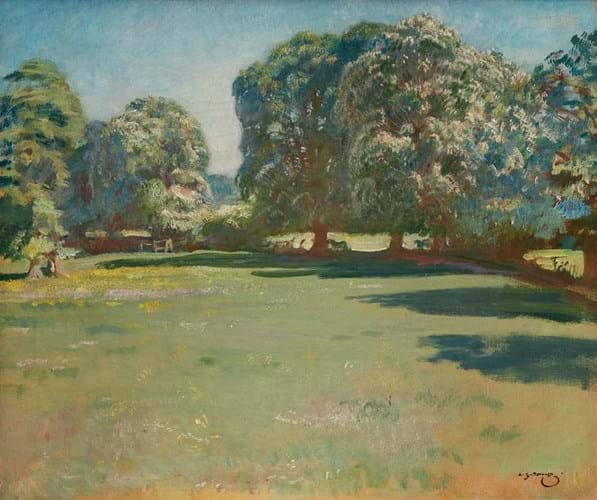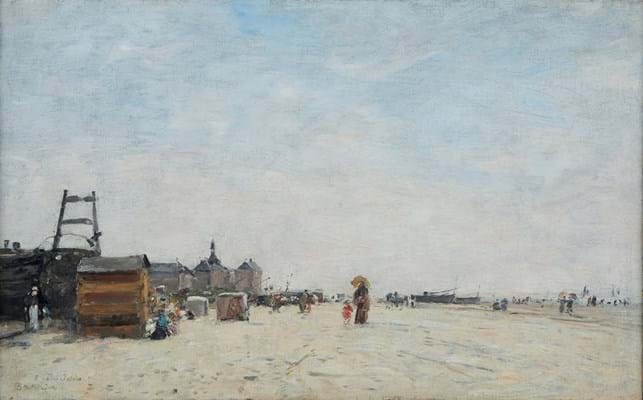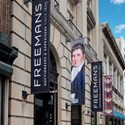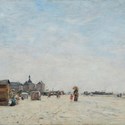Bidding levels across 139 lots ensured that chairman and auctioneer Alasdair Nichol – no slouch under usual sale conditions – spent close to four hours on the rostrum. The total of $4.9m (£3.6m) from 138 of those lots was among the auctioneer’s best ever and, said Nichol, “a testament to the calibre of the collection”.
Hamilton was considered Philadelphia blue blood. The heiress to a fortune made by her grandfather John Thompson Dorrance (1873-1930), who perfected the process of condensing Campbell’s soup, she was also synonymous with the city through her local philanthropic work. In the tradition of the Gilded Age, she owned a trio of homes: on the Main Line in Wayne, Pennsylvania, Boca Grande, Florida and Newport, Rhode Island.
Highest price
The undoubted highlight of the collection in financial terms was a small oil on canvas 11 x 14in (28 x 35cm) depicting Provençal farmhands at rest by Paul Cézanne (1839-1906). La Vie des Champs was painted at the time of the third Impressionists show in 1876-77.
This was among the items Freeman’s had taken on tour to London, Paris, Hong Kong and New York. An announcement was made before the sale that it was the subject of an irrevocable bid – the sort of third party financial guarantee that is commonplace among the New York elite but atypical for a second-tier auction house.

'La Vie des Champs' by Paul Cézanne – $1.2m (£890,000) at Freeman’s sale of the collection of Dorrance ‘Dodo’ Hill Hamilton.
The bidder, a UK dealer who reserved the right to continue bidding if necessary, secured the picture on its low estimate of $1.2m (£890,000). Perhaps this was not a prime-period Cézanne – a little too Impressionist rather than post-Impressionist in style – but it seemed a lot of picture for the money.
Shown at the Burlington Fine Arts Club in 1922 and the Leicester Galleries in 1925, dealers such as Ambroise Vollard, Pierre Matisse, Alex Maguy and Acquavella Galleries had owned the picture before it entered the collection of Elinor Dorrance Ingersoll, ‘Dodo’ Hamilton’s mother.
A typical plein air Pas de Calais beach scene by Eugène Boudin (1824-98) had set a livelier tone for the sale. Lot number one, La Plage de Berck, measuring 14 x 23in (36 x 59cm) and signed, located and dated E Boudin Berck Juin, had been a gift to Hamilton from her father. Estimated at a buyable $80,000-120,000, it sold to a phone bidder at $130,000 (£96,300).
Half a dozen phones competed Henri Fantin-Latour’s (1836-1904) 16 x 8in (42 x 20cm) oil titled Narcisses Simples et Doubles dans un Verre Long. Signed and dated [18]71, and probably painted in London, this study of white narcissi against a black background was acquired Arkell by Hamilton at Christie’s sale of the Schwarz collection in 2001.
At Freeman’s, pitched at $100,000-150,000, it took $230,000 (£170,400).

'Iris Germanica' by Pierre-Joseph Redouté, $160,000 (£118,500) at Freeman’s sale of the collection of Dorrance ‘Dodo’ Hill Hamilton.
Flowers were a theme of the sale. Hamilton was a dogged competitor at the Philadelphia Flower Show for almost three decades, winning close to 2000 blue ribbons and funding the $1m area for the show’s plant competitions that carries her name.
Four original botanical illustrations for Les Liliacées by Pierre-Joseph Redouté (1759-1840) had been acquired from Arader Galleries, New York. They were part of the group of watercolours on vellum created for the artist’s most celebrated volume and later presented to his patron, Empress Joséphine de Beauharnais. Sold by a descendent in Switzerland in 1935, they were resold at Sotheby’s, New York in 1985.
The most admired of the quartet was Iris Germanica, depicting two full violet blooms of the plant commonly known as the bearded iris.
Well beyond the estimate of $50,000-80,000, it found two phone bidders ready to lock horns. It sold to one of them at $160,000 (£118,500) – the third-highest price for a Les Liliacées watercolour.
More modest sums greeted the other three less imposing Redouté watercolours. Maianthemum took $9500 (£7050), Yucca Gloriosa $18,000 (£13,350) and Leucojum Aestivum $22,000 (£16,300).
“Hamilton was a dogged competitor at the Philadelphia Flower Show, winning close to 2000 blue ribbons”
Estimated at $40,000-60,000 but sold on the phone to a London dealer at $130,000 (£96,300) was Chestnuts in Bloom by Sir Alfred Munnings (1878-1959).
This 2ft 1in x 2ft 6in (64 x 77cm) oil, painted around 1920, depicts a view of the lawn and paddocks at Castle House in Dedham, Munnings’ home of 40 years and now the location of the Munnings Art Museum. A study of the same view, entitled View at Castle House, is in the museum’s collection.
A picture shown at a British Art Council exhibition at Hartford House in 1940, Chestnuts in Bloom had last appeared at auction in 1985 and was sold later that year by dealers Frost & Reid at an exhibition held at the Radnor Hunt Club in Pennsylvania.

'Chestnuts in Bloom' by Sir Alfred Munnings, $130,000 (£96,300) at Freeman’s sale of the collection of Dorrance ‘Dodo’ Hill Hamilton.
Blend of US Impressionism
American pictures followed – a blend of Pennsylvania and New England Impressionism.
A typical crowded beach scene by Newfoundland-born Maurice Brazil Prendergast (1858-1924) titled The Point, Gloucester sold well over hopes to a phone bidder holding paddle 1007 at $235,000 (£174,100).
An 18 x 21in (45 x 54cm) oil once owned by the artist’s brother Charles, it dates from c.1907-10.
This was among the pictures bought by the Philadelphia collectors Meyer and Vivian Potamkin in the 1950s and sold by Sotheby’s in a single-owner sale in 2003. Back then the premium-inclusive price was $187,200.
Another was The Walk Around The Island by Childe Hassam (1859- 1935). Signed and dated 1890, the subject of this 11 x 14in (28 x 36cm) oil was Appledore in the Isle of Shoals, off the coast between Maine and New Hampshire, a haven for an informal colony of artists, writers, and musicians.
Estimated at $200,000-300,000, it sold again to paddle 1007 at $350,000 (£259,300). The price was roughly the same as in 2003: a premium-inclusive $444,800.
The same bidder secured at $300,000 (£222,200) a second Hassam oil, titled White Church, Provincetown, that Hamilton had bought at Christie’s in 1985.
Kathleen Burnside, currently working on Hassam’s catalogue raisonné, assisted with the cataloguing. This 20 x 14in (51 x 36cm) picture was dated 1900 – the year, after travelling to Italy, that Hassan visited the artistic enclave of Provincetown in Massachusetts for the first time.
The picture’s title – given when the picture was shown at the Exhibition of Paintings by Hassam Childe held at the Saint Botolph Club, Boston, in autumn 1900 – references the white spire of the Universalist Meeting House that rises into the pale summer sky.
Audubon’s birds
Two hand-coloured prints from John James Audubon’s Birds of America, Roseate Spoonbill (1836) and Great White Heron (1835), sold at $65,000 (£48,150) and $60,000 (£44,450) respectively. Both had been acquired from Arader Galleries, New York in 2011.
Audubon painted the ‘Great White Heron’ during spring 1832, while on a voyage to the Florida Keys – his depiction of the rare bird the first seen in the West.
The spectacular Roseate spoonbill was commonly spotted in the mangrove swamps and marl flats of Texas and Florida in Audubon’s day. Their rosy plumage proved so popular for the making of fans that by the end of the American Civil War in 1865 the bird had completely disappeared.
However, a Mexican population remained untouched and it is through the efforts of the National Audubon Society that the birds have been reintroduced to the US.


















